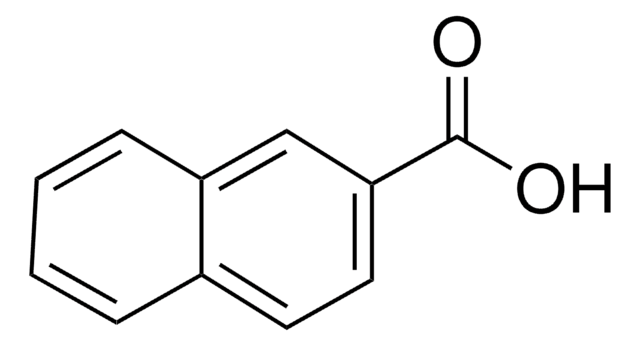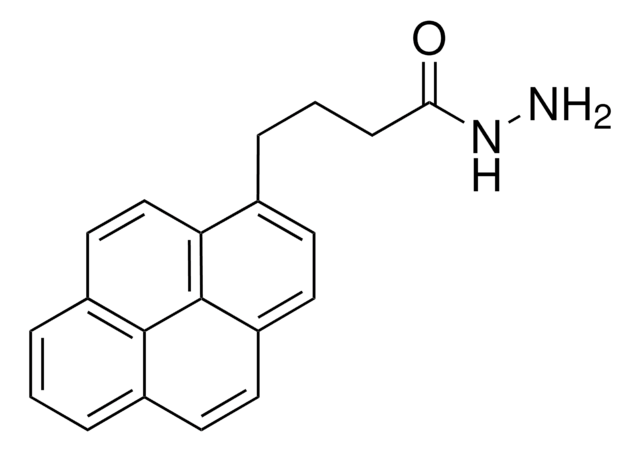392189
1-Pyreneacetic acid
97%
Synonym(s):
(1-Pyrenyl)acetic acid
Sign Into View Organizational & Contract Pricing
All Photos(1)
About This Item
Empirical Formula (Hill Notation):
C18H12O2
CAS Number:
Molecular Weight:
260.29
MDL number:
UNSPSC Code:
12352100
PubChem Substance ID:
NACRES:
NA.22
Recommended Products
Quality Level
assay
97%
form
solid
mp
210-212 °C (dec.) (lit.)
functional group
carboxylic acid
SMILES string
OC(=O)Cc1ccc2ccc3cccc4ccc1c2c34
InChI
1S/C18H12O2/c19-16(20)10-14-7-6-13-5-4-11-2-1-3-12-8-9-15(14)18(13)17(11)12/h1-9H,10H2,(H,19,20)
InChI key
SDJCLYBBPUHKCD-UHFFFAOYSA-N
General description
1-Pyreneacetic acid is a negatively charged pyrene derivative. It has been proposed as titrating reagent for the standardization titration of Grignard reagents and n-butyl lithium (n-BuLi).
Application
1-Pyreneacetic acid is suitable for use in the following studies:
- Synthesis of N-(2-(methylthio)ethyl)-2-(pyren-1-yl)acetamide, a pyrene amide based Pd2+ probe.
- Synthesis of pyrene-modified β-cyclodextrin.
- To functionalize single walled carbon nanotube field effect transistors (CNT FETs).
- As an agent for characterizing grafting degrees and reactivity of the ester functionalized polypropylenes.
- Synthesis sawhorse-type diruthenium tetracarbonyl complexes.
- Synthesis of (±)-2-(1-pyrenyl)propionic acid, a chiral carboxylic acid.
- Reversible noncovalent functionalization of single walled carbon nanotubes (SWNTs).
- Preparation of peptide nucleic acid (PNA) probes.
- As an internal reference compound in the assessment of solid phase reaction by HPLC-UV.
Storage Class
11 - Combustible Solids
wgk_germany
WGK 3
flash_point_f
Not applicable
flash_point_c
Not applicable
ppe
Eyeshields, Gloves, type N95 (US)
Choose from one of the most recent versions:
Already Own This Product?
Find documentation for the products that you have recently purchased in the Document Library.
Customers Also Viewed
Kadish KM, et al.
Handbook of Porphyrin Science: With Applications to Chemistry, Physics, Materials Science, Engineering, Biology and Medicine, Volumes 1-5, 1-5, 107-107 (2010)
Rappoport Z and Marek I.
The Chemistry of Organomagnesium Compounds, 288-288 (2008)
Mitchell B Lerner et al.
Journal of the American Chemical Society, 134(35), 14318-14321 (2012-08-17)
Despite the great promise of carbon nanotube field-effect transistors (CNT FETs) for applications in chemical and biochemical detection, a quantitative understanding of sensor responses is lacking. To explore the role of electrostatics in sensor transduction, experiments were conducted with a
Ali Khalil et al.
Polymers, 12(8) (2020-08-06)
Hydrophobic and amphiphilic derivatives of the biocompatible and biodegradable poly(dimethylmalic acid) (PdiMeMLA), varying by the nature of the lateral chains and the length of each block, respectively, have been synthesized by anionic ring-opening polymerization (aROP) of the corresponding monomers using
Fushen Lu et al.
Langmuir : the ACS journal of surfaces and colloids, 26(10), 7561-7564 (2010-01-06)
An effective purification method for single-walled carbon nanotubes (SWNTs) based on a combination of oxidative acid treatment and reversible noncovalent functionalization with 1-pyreneacetic acid is reported. The functionalization was selective toward the nanotubes, allowing a nearly complete removal of residual
Our team of scientists has experience in all areas of research including Life Science, Material Science, Chemical Synthesis, Chromatography, Analytical and many others.
Contact Technical Service












